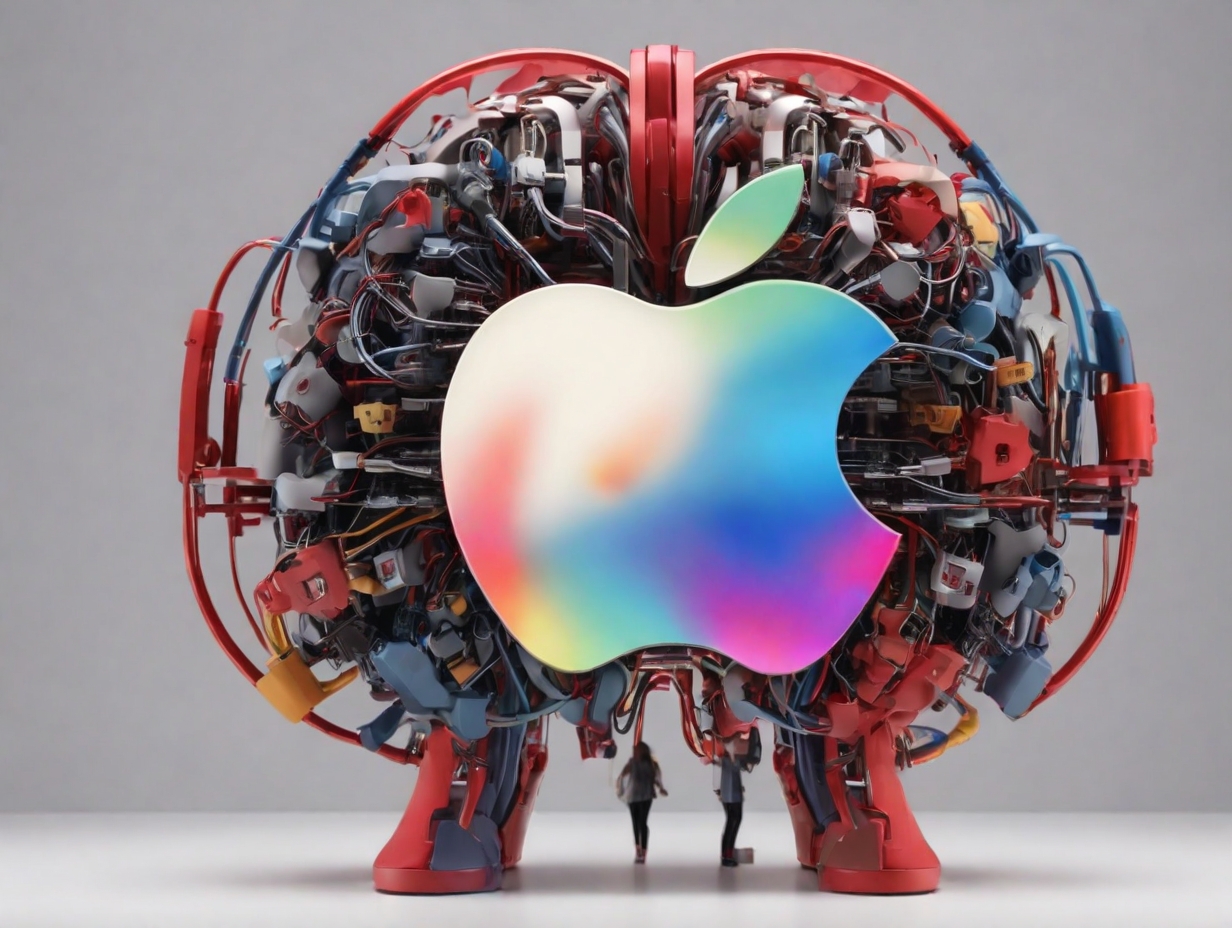Is Apple's AI Strategy Leading Or Lagging? A Competitive Analysis

Table of Contents
Apple's Strengths in AI
Apple possesses several significant advantages in the AI arena, primarily built upon its strong hardware and software ecosystem and unwavering commitment to user privacy.
Strong Hardware Ecosystem
Apple's tightly integrated hardware and software ecosystem provides a formidable foundation for AI applications. The A-series chips powering iPhones and iPads boast incredible processing power, enabling on-device AI capabilities that deliver speed, efficiency, and responsiveness. This contrasts sharply with cloud-dependent solutions, which require a constant internet connection.
- On-device AI features in iOS: Siri's improved natural language understanding, advanced image processing capabilities in the Photos app, and real-time translation features in Messages are all powered by on-device machine learning.
- Privacy advantages: Processing data locally on the device significantly enhances user privacy, a crucial differentiator in today's data-conscious world. Apple's AI operates without sending vast amounts of personal information to remote servers.
Focus on User Privacy
Apple's steadfast commitment to user privacy sets it apart from competitors who often rely on extensive data collection for training their AI models. While this approach might limit the scale of data available for training, it builds substantial trust with users, a key asset in the long run.
- Privacy-focused AI initiatives: Differential privacy techniques, on-device processing, and minimal data collection practices all reflect Apple's dedication to user data protection.
- Potential drawbacks: The limited data for training AI models compared to competitors with more permissive data policies could hinder the development of certain AI features, potentially leading to less sophisticated AI capabilities in some areas.
Strategic Acquisitions and Internal Development
Apple has strategically invested in AI through acquisitions and internal development. These efforts contribute significantly to its growing AI capabilities.
- Notable acquisitions: Acquisitions like Turi, Xnor.ai, and Inductiv have brought significant talent and technology to Apple's AI arsenal, bolstering its capabilities in machine learning and data analysis.
- Internal R&D: Apple's substantial investment in internal research and development teams focused on AI ensures ongoing innovation and the development of proprietary technologies.
Apple's Weaknesses in AI
Despite its strengths, Apple faces several challenges in the AI race. Its comparatively limited public-facing AI services and less open approach present significant hurdles.
Lack of Public-Facing AI Services
Unlike Google, which offers a wide array of publicly available AI-powered services (Google Assistant, Google Cloud AI, etc.), Apple has been more reserved in this area. This limited exposure potentially hinders broader adoption and feedback, slowing down iterative development and improvement.
- Comparison with Google: Google's extensive AI service ecosystem provides a rich source of data and user feedback, accelerating model training and improvement.
- Delayed releases: The delayed release of certain AI features or products compared to competitors indicates a more cautious and perhaps slower approach to product development.
Limited Openness and Developer Ecosystem
Apple's historically closed ecosystem, while contributing to a tight integration of hardware and software, limits the breadth of AI innovation compared to open-source platforms. This impacts third-party app development and AI innovation.
- Comparison with open-source platforms: Google's TensorFlow and other open-source platforms foster a vibrant community of developers, accelerating AI innovation and collaboration.
- Impact on third-party development: The lack of easily accessible tools and resources might limit the number of AI-powered applications developed by third-party developers for Apple's platforms.
Slow Adoption of Generative AI
Apple's progress in the rapidly expanding field of generative AI, including large language models (LLMs), has been relatively slow compared to OpenAI, Google, and other players. This lag could place them at a disadvantage in the long term.
- Comparison with competitors: Competitors are rapidly integrating generative AI into various products and services, while Apple's advancements in this space remain relatively less visible.
- Future implications: A continued lag in adopting generative AI could limit Apple's ability to compete effectively in emerging AI-driven applications and services.
Competitive Landscape Analysis
To fully grasp Apple's position, it's essential to analyze its competitors.
Google's AI Dominance
Google holds a commanding position across numerous AI sectors. Its extensive AI infrastructure, including search, cloud services (Google Cloud AI), and AI assistants (Google Assistant), presents a significant competitive threat to Apple.
- Examples of Google's AI leadership: Google's dominance in search, its advanced NLP capabilities, and its extensive cloud AI services all contribute to its leadership position.
Microsoft's AI Integration
Microsoft is aggressively integrating AI into its product portfolio, particularly through its partnership with OpenAI and its integration of AI capabilities into Bing and Azure. This strategic approach poses a serious challenge to Apple.
- Examples of Microsoft's strategic partnerships: Microsoft's close collaboration with OpenAI has given it access to leading-edge technologies like GPT models.
Amazon's AI-Powered Services
Amazon leverages AI extensively across its various businesses, from cloud computing (AWS) to e-commerce and smart home technology (Alexa). This broad application of AI represents another key competitor for Apple.
- Examples of Amazon's AI-driven offerings: Amazon's Alexa virtual assistant, its recommendation engine, and its robust cloud AI services are all significant competitive forces.
Conclusion: Is Apple Leading or Lagging in the AI Race?
Apple possesses significant strengths in AI, particularly in its hardware ecosystem and its commitment to user privacy. However, its relatively limited public-facing AI services, less open approach, and slower adoption of generative AI compared to competitors like Google, Microsoft, and Amazon indicate a lagging position in the broader AI race. While its focus on privacy and on-device processing is a key differentiator, Apple needs a more proactive and visible strategy to compete effectively in the long term. Apple's AI, while powerful, needs to be more accessible and integrated into a wider range of public services.
What do you think Apple needs to do to improve its AI strategy? Share your thoughts and join the discussion on Apple's artificial intelligence future!

Featured Posts
-
 Nyt Strands Hints And Answers Saturday February 15 Game 349
May 09, 2025
Nyt Strands Hints And Answers Saturday February 15 Game 349
May 09, 2025 -
 Troubled Nhs Trust Chief Pledges Cooperation In Nottingham Attack Probe
May 09, 2025
Troubled Nhs Trust Chief Pledges Cooperation In Nottingham Attack Probe
May 09, 2025 -
 Analyzing The Trump Presidency A Focus On Day 109 May 8th 2025
May 09, 2025
Analyzing The Trump Presidency A Focus On Day 109 May 8th 2025
May 09, 2025 -
 Oilers Draisaitl Injured Misses Game Against Winnipeg Jets
May 09, 2025
Oilers Draisaitl Injured Misses Game Against Winnipeg Jets
May 09, 2025 -
 Navigating The Chinese Market The Case Of Bmw And Porsche
May 09, 2025
Navigating The Chinese Market The Case Of Bmw And Porsche
May 09, 2025
